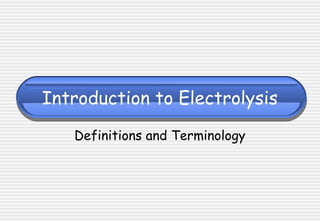
Introduction to electrolysis(older)
- 1. Introduction to Electrolysis Definitions and Terminology
- 2. Examination Requirements i) Electrolysis 1.39 understand an electric current as a flow of electrons or ions 1.40 understand why covalent compounds do not conduct electricity 1.41 understand why ionic compounds conduct electricity only when molten or in solution 1.42 describe simple experiments to distinguish between electrolytes and non-electrolytes
- 3. Examination Requirements 1.43 recall that electrolysis involves the formation of new substances when ionic compounds conduct electricity 1.44 describe simple experiments for the electrolysis, using inert electrodes, of molten salts such as lead(II) bromide 1.45 write ionic half-equations representing the reactions at the electrodes during electrolysis.
- 4. Definitions Electric current - a flow of electrons through a wire, or a flow of electrical charge through a conducting material. Electrode - a device for putting current into or taking current out of a conductor. Electrolysis - a process in which a compound is decomposed by an electric current.
- 5. Definitions (continued) Cathode - a negative electrode. An electrode with a surplus of electrons. Anode - a positive electrode. An electrode deficient in electrons. Electrolyte - a substance which, when liquid(molten) or in solution, conducts electricity and is decomposed by the current.
- 6. Definitions (continued) Ion - an atom, or group of atoms, with an electric charge. Metal ions are positively charged. Non‑metal ions are negatively charged. Anion - a negative ion which flows towards the anode during electrolysis. Cation - a positive ion which flows towards the cathode during electrolysis.
- 7. Electrolytes To be an electrolyte, the compound must contain ions to carry the electric current through the compound. The ions must be free to move so that they are attracted to the electrode of opposite charge. The ions are free to move in molten(melted) compounds or when the compound is dissolved in water. Electrolytes are; a) Ionic compounds (metal/non-metal compounds). b) Acids or alkalis. c) Salts.
- 8. Electrolysis of Lead(II) Bromide The electrode connected to the positive side of the battery is the anode. The electrode connected to the negative side of the battery is the cathode. +ve -ve graphite anode graphite cathode lead(II) bromide
- 9. Electrolysis of Lead(II) Bromide The battery is an ‘electric pump’ which provides the energy needed to push the electrons around the external circuit.
- 10. Electrolysis of Lead(II) Bromide Inside the electrolyte, ions are carrying the electric current. Electrons are gained at the cathode and electrons are removed at the anode. Effectively electrons move from the cathode to the anode. movement of anions movement of cations
- 11. Electrolysis of Lead(II) Bromide Inside the electrolyte, ions are carrying the electric current. Electrons are gained at the cathode and electrons are removed at the anode. Effectively electrons move from the cathode to the anode. movement of anions movement of cations
- 12. Movement of Ions During electrolysis, ions move through the molten electrolyte. The negative ions, anions, flow towards the anode. The positive ions, cations, flow towards the cathode. The bulb only lights when a current is flowing. If the electrolyte is solid, there are no free ions, so the charge (electric current) cannot be carried through the electrolyte.
- 13. Questions 1-3 1. What could be used instead of the bulb to show an electric current is flowing through the electrolyte? 2. Why is electrolysis classed as a decomposition reaction? 3. Is electrolysis exothermic or endothermic? Give a reason for your answer.
- 14. Ions at the Cathode When the positive ions arrive at the cathode, they gain electrons. Atoms are formed on the surface. M+ (l) + e- → M(s) Metals and hydrogen are formed at the cathode.
- 15. Ions at the Anode When the negative ions arrive at the anode, they lose electrons. Atoms are formed on the surface. 2X- (l) - 2e- → X2(g) Non-metals are formed at the anode, usually as molecules.
- 16. Equations for Lead(II) Bromide Reaction at cathode Pb2+ (l) + 2e- → Pb(l) Reaction at anode 2Br- (l) - 2e- → Br2(l)
- 17. Questions 4-5 4. What are the products for the electrolysis of the following compounds? For each compound, write the equations for the reactions at the anode and cathode. a) Sodium chloride, b) Magnesium oxide, c) Calcium fluoride, d) Iron(III) bromide. 5. What would be the products if a mixture of potassium fluoride and lead(II) iodide were electrolysed?
- 18. Metal Extraction Metals low down in the Reactivity Series can be extracted from solutions by electrolysis. This method is more often used for the purification of the metal, rather than the extraction of the metal from its ore.
